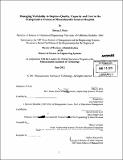| dc.contributor.advisor | Retsef Levi and David Simchi-Levi. | en_US |
| dc.contributor.author | Price, Devon J. (Devon Jameson) | en_US |
| dc.contributor.other | Massachusetts General Hospital. | en_US |
| dc.date.accessioned | 2011-09-27T18:37:32Z | |
| dc.date.available | 2011-09-27T18:37:32Z | |
| dc.date.copyright | 2011 | en_US |
| dc.date.issued | 2011 | en_US |
| dc.identifier.uri | http://hdl.handle.net/1721.1/66055 | |
| dc.description | Thesis (M.B.A.)--Massachusetts Institute of Technology, Sloan School of Management; and, (S.M.)--Massachusetts Institute of Technology, Engineering Systems Division; in conjunction with the Leaders for Global Operations Program at MIT, 2011. | en_US |
| dc.description | Cataloged from PDF version of thesis. | en_US |
| dc.description | Includes bibliographical references (p. 41-42). | en_US |
| dc.description.abstract | The widely held assumption is that to improve access and quality of health care, we need to spend more. In fact, that is not necessarily true. The results of this project, performed at Massachusetts General Hospital (MGH), demonstrate that more sophisticated management of health care processes will lead to greater capacity and higher quality at lower cost. This work includes system-level analysis of surgical patient flow and reveals several opportunities for performance improvement. The results show that management of variability, both intrinsic to and generated by the perioperative department', will result in lower patient wait times, less crowding, and ultimately higher throughput for surgical patients throughout the hospital. The solution developed here is an "open block" scheduling policy for the operating rooms at MGH. It was designed with the aid of a discrete event simulation model, which was used to refine the policy and predict the impact of the change. By more effectively characterizing and managing the stochastic demand of non-elective surgical cases, this policy will dramatically reduce delays and open capacity for higher case volume. Specifically, it will reduce the number of non-elective surgical patients exceeding maximum recommended wait time from 30% to 2%; it will free up an average of seven inpatient beds per day; and it will lay the foundation for increased operating room utilization - by up to the equivalent of five operating rooms. Indeed, this is merely one example demonstrating that by focusing our efforts on creative healthcare system design and management, we can meet the needs of society and spend less doing so. | en_US |
| dc.description.statementofresponsibility | by Devon J. Price. | en_US |
| dc.format.extent | 42 p. | en_US |
| dc.language.iso | eng | en_US |
| dc.publisher | Massachusetts Institute of Technology | en_US |
| dc.rights | M.I.T. theses are protected by
copyright. They may be viewed from this source for any purpose, but
reproduction or distribution in any format is prohibited without written
permission. See provided URL for inquiries about permission. | en_US |
| dc.rights.uri | http://dspace.mit.edu/handle/1721.1/7582 | en_US |
| dc.subject | Sloan School of Management. | en_US |
| dc.subject | Engineering Systems Division. | en_US |
| dc.subject | Leaders for Global Operations Program. | en_US |
| dc.subject | Massachusetts General Hospital. | en_US |
| dc.title | Managing variability to improve quality, capacity and cost in the perioperative process at Massachusetts General Hospital | en_US |
| dc.type | Thesis | en_US |
| dc.description.degree | S.M. | en_US |
| dc.description.degree | M.B.A. | en_US |
| dc.contributor.department | Leaders for Global Operations Program at MIT | en_US |
| dc.contributor.department | Massachusetts Institute of Technology. Engineering Systems Division | |
| dc.contributor.department | Sloan School of Management | |
| dc.identifier.oclc | 752313786 | en_US |
